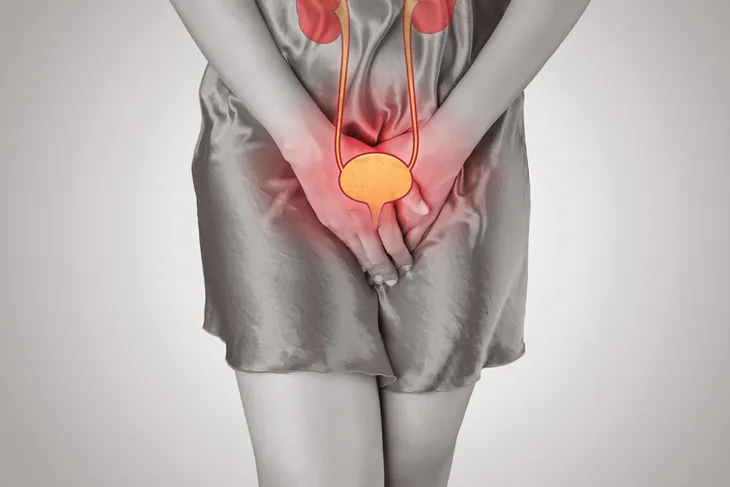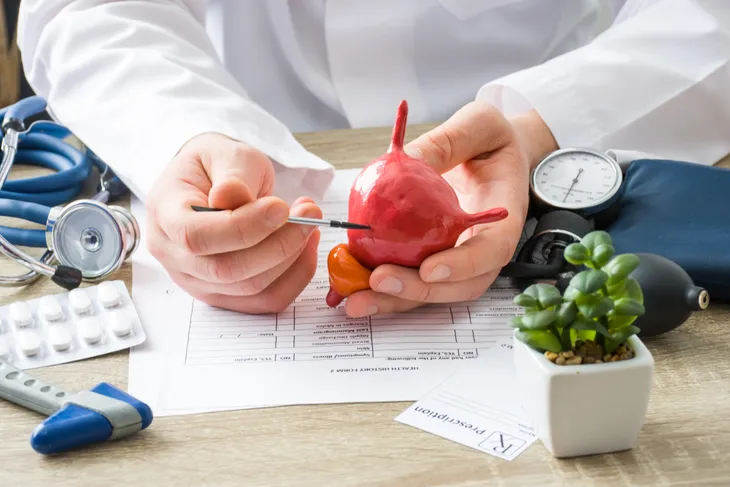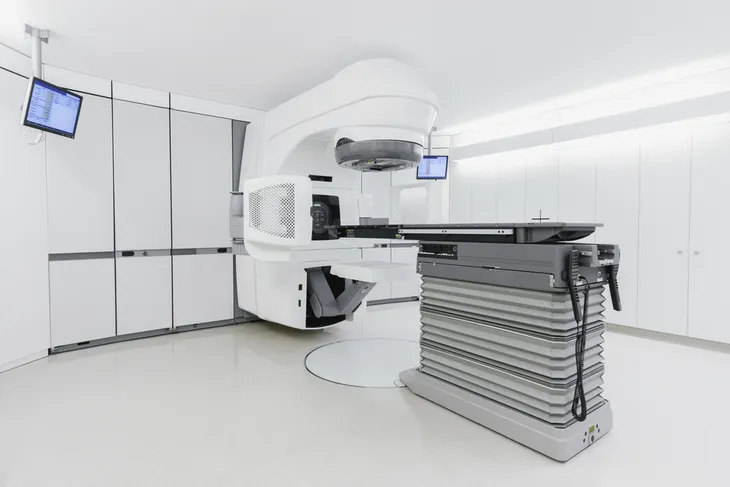- Bladder cancer is one of the most common types of cancer in the United States, with approximately 81,180 new diagnoses each year.
- It’s challenging to identify in its early stages as symptoms don’t typically appear until the tumor grows larger or into the deeper layers of the bladder wall.
- Some common symptoms include blood in the urine, pain during urination, and urinary frequency.
- Common bladder cancer treatment options include surgery, chemotherapy, radiation therapy, immunotherapy, and targeted therapy. Your treatment plan will depend on a variety of factors such as your age, overall health, and the location and stage of cancer.
Bladder cancer is among the most common types of cancer, with approximately 81,180 new diagnoses in the United States each year—the vast majority of which are in males. According to the American Cancer Society, this accounts for “about 5-percent of all new cancers in the US.”
Despite how common it is, bladder cancer is challenging to identify in its early stages, as it may not show any signs or symptoms. Typically, “symptoms appear once the tumor grows larger or into the deeper layers of the bladder wall,” says the Canadian Cancer Society. Because of the late onset of symptoms, it’s important to identify them quickly so as to begin treatment right away. Here are the five most common ones to be mindful of.
Blood in the Urine
Blood in the urine, medically known as hematuria, is the most common symptom of the disease, occurring in “8 or 9 out of 10 people who have bladder cancer,” says WebMD. Hematuria isn’t always a consistent issue, though. According to the Canadian Cancer Society, “Blood may always be in the urine, or it may come and go.”
And even when it is present, the source says, it may cause the urine to vary in color, “from pale yellow-red to bright or rusty red.” In some cases, the blood may not even be visible to the naked eye; this is known as microscopic hematuria, as it is only identifiable under a microscope.
Pain During Urination
Experiencing pain, discomfort, or a burning sensation while urinating is also common. This is medically known as dysuria, and while it may be due to bladder cancer, other possible causes can include urinary tract infections, bladder stones, or an enlarged prostate (in men).
To distinguish dysuria caused by bladder cancer from that caused by a urinary tract infection, for instance, the Bladder Cancer Advocacy Network suggests “a urinalysis and/or culture are done to detect any bacteria in the urine.” If no bacteria are present, an infection can be ruled out and the person “should be referred to a urologist for further testing.”
Urinary Frequency and Urgency
Other urination issues that commonly occur with bladder cancer include the need to urinate often (known as urinary frequency) and urinary urgency, which MedicineNet.com defines as “an inability to hold the urine for any length of time after the initial desire to void.”
As the disease progresses, the individual may struggle to pass any urine at all. This symptom is often due to a growing tumor blocking the urine from getting to the urethra (the tube from the bladder to the outside world) and exiting the body.
Flank Pain
Pain in the lower back around the kidneys, which is known as flank pain, more commonly occurs as bladder cancer becomes advanced. MedicineNet.com says it is “due to obstruction of urine flow from kidney to the bladder by the growing tumor mass in the bladder.”
WebMD adds that flank pain is often felt “just below the rib cage and above the waist” and can occur on “one or both sides of the back.” Additionally, it tends to worsen as the bladder fills up, and in some cases, the pain may even extend to the bladder and surrounding areas, such as the genitals.
Other Late Symptoms
There are a wide variety of other symptoms that may present as bladder cancer progresses or spreads to other areas of the body. According to the Canadian Cancer Society, one such symptom is “swelling in the legs, scrotum (the pouch of skin below the penis that contains the testicles) or vulva (the outer female sex organs).”
Other symptoms include a growth in the pelvis, as well as pain in the bones of this area. The individual may also suffer from a loss of appetite, which can lead to weight loss. Additionally, they may have frequent fevers or struggle with anemia.
Bladder Cancer Treatment
If your doctor confirms a bladder cancer diagnosis they will then suggest a treatment plan. Your treatment will depend on a variety of factors including your age, overall health, the location and stage of cancer, and your treatment preferences.
Common bladder cancer treatment options include surgery, chemotherapy, radiation therapy, immunotherapy, and targeted therapy. In some cases, your doctor may recommend a combination of treatments. Let’s take a closer look at what each of these treatment options entails.
Treatment: Bladder Cancer Surgery
Medical News Today says surgical options are available for all stages of bladder cancer. For starters, patients with stage 0 and 1 bladder cancer may receive transurethral resection of bladder tumor (TURBT). During this surgery, small tumors and abnormal tissues are removed. The surgeon may also burn away any other cancerous cells.
If the cancer is larger or has spread deeper into the bladder, a cystectomy may be necessary. This procedure removes the whole bladder, along with the cancerous tissue. Finally, after a cystectomy, you’ll likely require reconstructive surgery. The goal of this procedure is to, “help provide a new way for the body to store and remove urine,” says the source.
Treatment: Chemotherapy
Chemotherapy uses drugs to destroy cancer cells (or to shrink tumors). When treating bladder cancer, two or more chemotherapy drugs are typically used.
The chemotherapy drugs can be distributed in two ways, through a vein (intravenously) or directly into the bladder (intravesical therapy). Intravenous chemotherapy is typically used before a cystectomy (bladder removal surgery) in hopes of curing the cancer, however, it can also be used after surgery to destroy any cancer cells that remain.
Explaining Intravesical Therapy
The other way chemotherapy is given is by directly administering the drugs into the bladder, also known as intravesical therapy. During this treatment, a tube passes through your urethra into your bladder. “The chemotherapy is placed in the bladder for a set period of time before being drained,” explains the Mayo Clinic.
This treatment may be used as the initial treatment for superficial bladder cancer, says the source. This is when the cancer cells only affect the lining of the bladder.
Treatment: Radiation Therapy
The Mayo Clinic explains that radiation therapy “uses beams of powerful energy, such as X-rays and protons, to destroy the cancer cells.” When used to treat bladder cancer, energy beams are directed to precise points on your body.
Medical News Today points out that radiation therapy is a less common intervention for bladder cancer, however, your doctor may combine it with chemotherapy. This is sometimes the case when surgery isn’t an option.
Treatment: Immunotherapy
Immunotherapy is a drug treatment that has the primary goal of helping your immune system fight cancer. Like chemotherapy, immunotherapy can be given directly into the bladder (intravesical therapy) or through a vein (intravenously).
Patients who have advanced bladder cancer or who have cancer that comes back after treatment typically receive immunotherapy intravenously. Whereas, intravesical immunotherapy may be the treatment route for a patient with “small bladder cancers that haven’t grown into the deeper muscle layers of the bladder,” says the Mayo Clinic.
Treatment: Targeted Therapy
Another treatment option for bladder cancer is targeted therapy. This treatment “uses drugs to target specific molecules (such as proteins) on cancer cells or inside them,” explains the Canadian Cancer Society.
The goal of the drugs is to stop the growth and spread of cancer cells while also limiting harm to your normal cells. It’s worth noting, you may also receive other treatments along with targeted therapy.
Treatment: Trimodality Therapy
Trimodality therapy is a combination of treatments. This is usually an option when the patient doesn’t want to undergo surgery to remove the bladder.
Trimodaliy therapy combines TURBT, chemotherapy, and radiation therapy, says the Mayo Clinic. You’ll first undergo a TURBT procedure to remove as much cancer as possible while still preserving bladder function. Following this procedure, you’ll then receive chemotherapy along with radiation therapy.
The source also notes that if all of the cancer isn’t destroyed after trimodality therapy, your doctor may recommend a radical cystectomy.
 novak.elcic / Shutterstock
novak.elcic / Shutterstock














